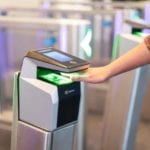 IDEMIA had a huge presence at the 2018 Money20/20 USA event in Las Vegas last month, and FindBiometrics President Peter O’Neill had the opportunity to talk with multiple executives from the company live on the show floor. Among them was Gary Jones, the head of the company’s Biometric Access & Time Solutions division, who chatted with O’Neill about IDEMIA’s MorphoWave contactless fingerprint scanner and its potential applications in financial services.
IDEMIA had a huge presence at the 2018 Money20/20 USA event in Las Vegas last month, and FindBiometrics President Peter O’Neill had the opportunity to talk with multiple executives from the company live on the show floor. Among them was Gary Jones, the head of the company’s Biometric Access & Time Solutions division, who chatted with O’Neill about IDEMIA’s MorphoWave contactless fingerprint scanner and its potential applications in financial services.
Since that brief chat, FindBiometrics has had the opportunity to dive into a more in-depth interview with Jones about IDEMIA and its compelling biometric solutions. In their wide-ranging discussion, the two discuss IDEMIA’s concept of “Augmented Identity,” its activities in financial services as well as other vertical markets, the growing importance of artificial intelligence in IDEMIA’s solutions, and where the biometric security industry is headed. And, once again, they can’t help but touch on the “game changer” that allows users to authenticate with the wave of a hand – the MorphoWave.
Read our full interview with Gary Jones, Global Channel & Marketing, Biometric Access & Time Solutions, IDEMIA:
Peter O’Neill, President, FindBiometrics: The new positioning for IDEMIA is, “We stand for Augmented Identity.” Can you please tell our readers about this focus?
Gary Jones, Global Channel & Marketing, Biometric Access & Time Solutions, IDEMIA: The concept is to ensure that security can become a natural and easy part of life in everything that we do. With the need to identify ourselves to so many different systems today, through so many different types of technologies, instead of it becoming more cumbersome as we try to make sure we don’t reuse passwords and being diligent around how we handle our identity, we use technology to make that process easier, but also at the same time to reach even higher levels of security than ever before. We will achieve that primarily through technology whether it be hardware, software, services or solutions, and we want it to be an absolutely transparent experience for the user. It needs to be completely natural and not invasive.
FindBiometrics: Those are all wonderful goals. Where do you, as the old MorphoTrak, fit into the new organization?
IDEMIA: Our particular business unit is focused on physical access control and time & attendance, including workforce management and single sign-on. Another extension of the technology is membership-based systems, for example, granting access to a gym or airline lounge. Anywhere you might use biometrics to authenticate a person when they require access to a system or location, i.e., physical or a logical systems.
FindBiometrics: IDEMIA participated in our month-long focus on financial services in October, in conjunction with Money20/20, the world’s largest FinTech show. Can you please tell us about your focus in this particular vertical market?
IDEMIA: Sure, I’ll start with my direct area of responsibility, which is a key part of IDEMIA’s business but also one where we are looking to drive increased awareness within the financial sectors. Physical security is something that we often find is overlooked in the big picture of all the different types of security that are needed to secure financial institutions. Compliance, ethical responsibility to employees, shareholders, and customers alike must all factor in security decisions and practices. We already supply a huge number of the world’s leading banks with biometric technology for the purpose of physical access control, but we believe there is a lot more ground to cover with some of the smaller to medium sized banks who need to follow suit. Typically, the very large banks are well ahead in terms of their adoption of biometrics for secure physical access. I don’t mean only in the high security areas like data centers or bank vaults or bank branches, but also in their general corporate facilities, making sure that workplaces are safe and secure, and allowing the right people in while making sure that the wrong people do not get in.
So, that is something we put an extra emphasis on this year at Money20/20.
During Money2020, IDEMIA’s experts from our Financial Institution business unit were showing an impressive array of technologies to be used at home, in store or in the branch. These included ID verification and biometric enrollment systems, particularly important in KYC applications. The next key step is advanced payment card enrollment and issuance. IDEMIA has industry leading payment card technology such as Motion Code, which embeds a dynamic security code digitally into the card, and F.Code, which embeds a fingerprint sensor directly into the payment card for secure biometric authentication. And last but not least, there’s IDEMIA’s innovative Blink card solution, which allows customers to transact from a variety of account types with a single card hosting onboard LED feedback technology.
For “at-home” or “on-the-move” type applications, we demonstrated remote ID-Proofing, with strong authentication and spoof detection, as well as digital issuance. An example would be opening a bank account from the comfort of your living room.
Our in-store solutions included multiple biometric authentication tools as part of the account creation and/or payment process, including the award winning MorphoWave and IDEMIA’s leading facial recognition solutions. These are the types of technology that will enable the stores of the future to offer customers a highly secure, yet frictionless and convenient shopping experience.
Customers and consumers can benefit greatly from IDEMIA’s unmatched experience in large scale biometric enrollment and verification systems. One example of this is the world’s largest Civil ID program Aadhaar, where IDEMIA provided biometric solutions to enroll over one billion citizens in India, and mobile biometric technology that could subsequently be used to create bank accounts for the previously unbanked population, even in the most remote rural parts of the country. Developing systems to serve projects of this scale is the ultimate test of any vendor’s capabilities, and IDEMIA is the proven market leader in these large-scale programs.
FindBiometrics: You have one of my favorite biometric products in your lineup – the MorphoWave. Can you tell our readers about this and its new compact version, its uses and also why it has become so popular?
IDEMIA: Thanks Peter! It is not only my personal favorite but also the favorite of most of the big banks globally, and there are a few very natural reasons for that. The technology is definitely cutting edge as it scans fingerprints using two different channels of light. In other words, we are able to scan fingerprints in three dimensions and we do it at a very rapid frame rate or very high speeds. It is a major breakthrough in the industry because usually when you increase security you have an inversely proportional effect on convenience. In other words, you have a negative effect on convenience. Because of how powerful this technology is, we are able to increase both security and convenience at the same time. So, for a user it means a simple wave of the hand through the scanner at pretty much any walking or even fast walking pace: the users don’t have to stop what they are doing, they don’t have to pay specific attention, they can continue their call on their phone or continue their conversations, etc. It is a very seamless process. The technology is able to scan in excess of 45 people per minute and it really comes down to what kind of barrier you put in place. And the other key benefit, unlike many other contactless technologies, is that it is totally immune to external factors, meaning that the customers don’t need to worry about engineering the environment. That is very important because, particularly in the corporate world of banking, customers spend a lot of money to make their facilities look beautiful and attractive and they also try to achieve LEAD certification for energy-efficient buildings, and if they have to start competing with nature to either block out light or overpower a natural light, that can not only be expensive but an eyesore. So, the fact that the MorphoWave technology can operate in anything from total darkness to very brightly lit conditions is another unique point for this technology.
We have had tremendous adoption through our major banking customers; it’s used not only for the high traffic areas such as lobbies in corporate facilities, but also, with the MorphoWave Compact’s much smaller form factor wall mount version, it can be installed at any door, any location, including outdoors. So, it has been tremendously successful in this space.
FindBiometrics: I remember vividly when you first showed me this product, the MorphoWave, I think it was about three or four years ago at ISC West, and I knew then that it was going to be a game changer. I remember testing it out and just couldn’t believe how fast and easy it was – it’s just totally frictionless.
IDEMIA: Absolutely and we still get that same positive reaction today, even though it is almost four years since we launched the MorphoWave Tower in 2015. People are still blown away when they see it for the first time.
One of the things I should mention is that we have had discussions with a lot of our large banking clients about the challenges they face regarding getting buy-in from users to comply with security. It is no easy task to be a security manager in a large organization when you have tens of thousands of employees and getting stakeholder buy-in at all levels is a real challenge. So, you have to have a technology that is easy to use and if it can portray an image of being high tech, that is highly beneficial because people like using it. When you look at the challenge that the major banks face attracting talent, workplace of the future is an evolving concept where companies compete by creating workplaces that are attractive to employees in order to hire top talent. It may seem surprising, but that kind of incentive goes all the way down to how easily can you get access to your workplace and how cool the experience is when you walk into your own building each day; every element counts in the competitive world that we live in today.
FindBiometrics: We talked a little bit around IDEMIA’s focus on financial. What other vertical markets excite you right now looking forward over the next five years?
IDEMIA: One of the major ones in public security, particularly in the transportation sector, is ports and airports. Border control specifically is a huge challenge. Anywhere a large number of passengers are moving through border gates is a big risk for any given country. So, in providing technology that catches the bad guys, IDEMIA helps law enforcement know where bad people are moving. Our technology lets officers apprehend the bad guys quickly and efficiently when they are detected at these key points. This is a very big part of what we do. And this is really in our bloodline on the Morpho side of the business, particularly where we have provided the world’s largest users of biometrics for over four decades, including the FBI and Interpol who rely on the technology for law enforcement and counter terrorism, and basically catching the bad guys.
In the same area, key or critical infrastructure, given the importance for national security, is another major priority, whether it is nuclear power plants, traditional power plants or water treatment facilities. All of these are facing increased risk of attacks these days. Those kinds of customers are putting a lot more attention on physical security and also logical security to prevent multiple forms of intrusion and attack.
FindBiometrics: What about some of the new areas: autonomous vehicles, robotics, artificial intelligence which is creeping into everything, what do you think about those areas?
IDEMIA: On the AI side, that plays a big role in the products we develop at IDEMIA. Many of our solutions are based on algorithms, particularly on the biometrics side for tracking and matching. So, things like deep learning have a very big impact on the ability to process transactions faster and also bring opportunities for increased accuracy. A really great example is the way we evolve our algorithms as processing power increases, as feedback goes into the algorithms, over hours, years and decades. What really gives me great pleasure, and it is one of the most rewarding parts of being in this industry, is when we hear from our law enforcement customers after they deploy our systems and run legacy records, in other words cold cases, unsolved crimes, through the technology. Over the years with the increase in performance of these systems, cases that were previously unsolved or unsolvable, become solved. Although this kind of incremental gain has been happening steadily for the last four decades we think that AI is the next big contributor to providing some big leaps in both accuracy as well as matching speed.
Another key area for AI is of course the automotive industry. We have a connected objects team that focuses specifically on these types of applications, leveraging biometrics and other forms of sensors into vehicles to increase the safety of the driving experience, and also to provide better security in the process as well.
FindBiometrics: You and I have known each other for many years in this industry and have had a lot of chats on where the industry is heading, what the challenges are, what the opportunities are. What are you seeing now?
IDEMIA: For us, particularly in the security part of the business, the whole concept of remote identification or even if you want to refer to it as frictionless or contactless biometrics is obviously something that is getting a lot more attention now. There are close range applications for touchless or contactless technology like the MorphoWave where you need to know very precisely where the person is before you unlock a door or open a turnstile, and in the case of the MorphoWave we know that the person can not physically be more than an arm’s length away. That gives you the proximity assurance that you need to make a high confidence decision to unlock a door or turnstile, for example. But there are certainly many applications where you need to do authentication from a much greater distance, for example for stadium security or even in a large airport terminal.
A lot of the work that we are doing is taking the tools that we have provided to major customers, in law enforcement particularly, so that they can be adapted for use in more commercial applications. And again, the simple use case is high profile customers have different types of threats to protect against, and they want early detection far out from their perimeters, or as you go through the different perimeters in their facilities. So, they are looking for that early detection, they want to be able to have and manage their own watch list of potential threats. Alternatively, the complete opposite application of that technology is that you can just as easily use it for something in the frame of VIP identification as opposed to just looking for bad guys or threats. The ability to use it for VIPs or particular types of customers, for example in retail or hospitality, has a huge amount of value as well. So, it has really diversified the types of use cases and the types of customers that we work with today.
And in some cases, the other benefit is that one customer can use exactly the same technology for both applications at the same time. In a casino for example, you can identify your VIPs and make sure somebody gives them the right level of service, but at the same time you can identify your known cheaters with the very same technology. So, the ROI is getting better and better all the time with these big biometric systems.
FindBiometrics: There just seems to be so many drivers for our industry right now. It used to be, when I first met you many, many years ago, it was mostly law enforcement, the odd border control, defense and now it is in every industry – every vertical market is now moving to biometrics and I think also about your earlier comment about the acceptability of biometrics. I think the acceptance of mobile biometrics has really changed the dynamics. I don’t think we’re faced as an industry so often now with the need of convincing everybody, in fact it seems they are demanding biometrics because of convenience, because of additional security and because they are fed up with passwords.
IDEMIA: Yes, that’s right and I’m glad you mentioned that point because we always used to refer to three key things in our business: security, productivity and convenience; three inherent values that you can get out of using biometrics and the convenience one was so often overlooked. But I think you are right, that the mobile adoption of biometrics has helped people naturally experience the convenience for themselves, and has increased the interest in actually using it in more and more places outside of their cell phone. We have had over the decades some really fascinating experiences. As you know very well, from country to country or region by region, you get different levels of willingness of people to cooperate in different biometrics systems. But let’s take an arbitrary adoption rate of 90 percent in a given system and what we have always seen irrespective of the region or country is that once the 10 percent who may have initially opted out see their colleagues experience the benefit and ease of using the system on a daily basis it doesn’t take long, sometimes it might take months, but usually it is only a few weeks after deployment that those 10 percent will come back and opt-in to use the system.
Again, I think it is just an education thing and it is also important that when you deploy these systems that they are done right; you need to make sure you are complying with regulations, particularly these days with GDPR and similar regulations. And if you do it the right way and protect the user’s data and give the users options, the buy-in rate and adoption rate is becoming very high these days.
FindBiometrics: Well Gary thank you very much for taking the time to speak with us today. I know you have a very busy international schedule and we really appreciate it. It was great seeing you in Vegas at Money20/20 and thank you for participating in our Financial Biometrics Month webinar. Always a pleasure.
IDEMIA: Peter, likewise, thanks so much for your time and looking forward to catching up again soon.



![[Money20/20] IDEMIA VP Gary Jones On Frictionless Biometrics at the Bank](https://idtechwire.com/wp-content/uploads/MorphoWave-at-Money2020-e1540495351401-150x150.jpg)




Follow Us